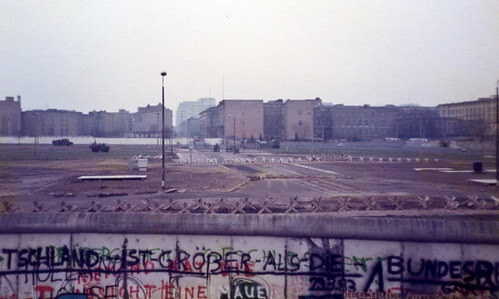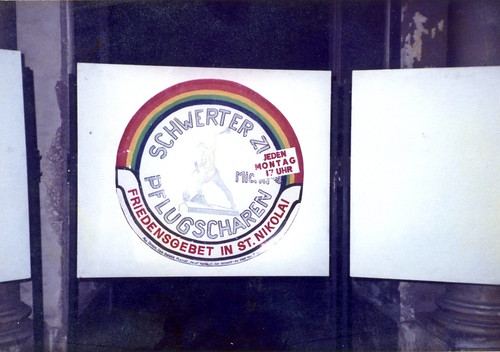Yesterday I was listening to BBC Radio 4, and they were remembering the people who died, shot by East German border guards. It doesn’t seem to occur to our official voices of commemoration that there are parallels today with the thousands who die trying to escape tyranny, war or poverty and who drown in the Mediterranean, perish from thirst in the Arizona desert, or with those who the Australian government turns back at sea or interns offshore. Nor do such barriers as the “separation wall” in Palestine seem to evoke such horror in those voices as the Berlin Wall did then. These newer barriers are treated as necessary and normal and those deaths as self-inflicted by people naive enough to believe that a better life awaits in prosperous liberal democracies. Not that free movement is the only thing where official attitudes have changed. It isn’t long since the comprehensive surveillance of citizens depicted in Anna Funder’s *Stasiland* and in the film *Das Leben der Anderen* was emblematic of how communist states would trample on the inalienable rights of people in pursuit of state security. Today we know that our states do the same. I’m not making the argument that Western liberal democracies are “as bad” as those states were, lest any commenter come along and moan about “moral equivalence”. But I note that these kinds of violations were not seen back then as being impermissible because those states were so bad in other ways — undemocratic, dirigiste — but rather were portrayed to exemplify exactly why those regimes were unacceptable.
Here’s my photoblog from five years ago:
Two photos today. My partner, Pauline Powell and I visited East Germany and West Berlin in 1984. The first picture is a shot of the Berlin Wall from the western side, and seems appropriate as tomorrow is the 20th anniversary of its fall. The second shot, taken inside the Nikolaikirche in Leipzig, announces one of the prayers for peace meetings that helped to build the popular movement that would eventually contribute to the fall of the regime. Both pictures are Pauline’s, not mine (all rights reserved etc). We believe the swords into ploughshares picture is unique on the web, though perhaps others exist as prints. As such, it is something of a historic document.


{ 14 comments }
Gareth Wilson 11.09.14 at 9:09 am
Not many guns pointed inwards, these days.
ZM 11.09.14 at 9:23 am
” It doesn’t seem to occur to our official voices of commemoration that there are parallels today with the thousands who dies trying to escape tyranny, war or poverty and… with those who the Australian government turns back at sea or interns offshore. ”
We had a screening of the film No Fire Zone today about Sri Lanka and the killing of tens of thousands of Tamils in what were declared no fire zones during the late stages of the civil war, this included firing on tens of medical centres.
http://youtu.be/80zeldAWmVQ
In the last 18 months our governments have sent back around 1500 Tamils to Sri Lanka despite reports of ongoing torture of Tamils there, and there are around 60 Tamils in indefinite detention in Australia due to secret ASIO security reports. A Tamil man living in Melbourne returned to Sri Lanka due to the ill health of an uncle and was picked up and bound, tortured with hot irons, and sexually abused by the Sri Lankan military. The Sri Lankan government has used a post 2001 UN resolution to put hundreds of Tamils on international terrorist watch lists.
But our Prime Minister this year described Sri Lanka as “a country at peace” and “I believe that there has been a lot of progress when it comes to human rights and the rule of law in Sri Lanka” while last year he said “difficult things happen” with regard to war crimes and human rights abuses.
Sasha Clarkson 11.09.14 at 10:56 am
It’s worth noting that many of these East German border guards were teenage conscripts. In the early nineties, I was taken to see some memorials to those shot whilst escaping by a gentleman who had been a top psychologist in the East Berlin military hospital. One of his rôles had been to counsel and treat the traumatised young soldiers who had done the shooting. Although not a party member or regime supporter, he had nonetheless been a part of the system and was clearly uncomfortable with that fact.
Of course his skills and experience were too valuable to waste. He later spent time in Bosnia and Afghanistan helping NATO troops with post-traumatic stress disorder.
ogmb 11.09.14 at 12:10 pm
https://soundcloud.com/berlinwallofsound/the-berlin-wall-of-sound
Corey Robin 11.09.14 at 1:48 pm
” seems appropriate as tomorrow is the 20th anniversary of its fall.”
25th, no?
JM 11.09.14 at 2:44 pm
I visited Berlin the summer after the wall fell. There was (still is???) a fence near the Brandenburg Gate with white crosses giving names and dates of those who died trying to escape. Many of the names were simply “Unbekannt”. The date for one of the Unbekannten was about nine months before the wall fell. I found that simple little cross lost in a sea of other crosses, together with the knowledge that waiting a year would have saved his or her life, to be powerfully moving.
Chris Bertram 11.09.14 at 3:01 pm
Yes Corey. That’s the bit that quotes my blog from 5 years ago !
engels 11.09.14 at 3:11 pm
Self-plagiarism ;)
Corey Robin 11.09.14 at 3:16 pm
Oops! My mistake.
ifthethunderdontgetya™³²®© 11.09.14 at 6:28 pm
We believe the swords into ploughshares picture is unique on the web, though perhaps others exist as prints.
For quite a while now, we’ve been the number one country on earth doing the opposite.
USA! USA! USA!
~
eric 11.09.14 at 10:15 pm
A political art group has actually made the link between the ‘Wall then’ and ‘the borders now’ visible. They took the crosses dedicated to the Wall victims (as mentioned above) and placed them at different spots on the fenced EU borders.
http://www.politicalbeauty.de/index.html
Their page is so far unfortunately in German only. More in English here:
http://www.washingtonpost.com/blogs/worldviews/wp/2014/11/04/to-some-the-e-u-s-deadly-border-is-the-new-berlin-wall/
They put also a video on youtube, again German only:
gianni 11.09.14 at 10:27 pm
thanks for the links eric
James Wimberley 11.10.14 at 11:05 pm
“Swords into ploughshares” was not a leap of Isaiah’s imagination. There’s a panel at the probable site of the Battle of Bosworth in 1485 that explains why it’s only probable. It’s quite rare to find buried weapons at medieval battle sites, so their absence isn’t evidence. The reason is that after the soldiers on the winning side had taken away anything serviceable or saleable, the local peasantry went over the site again to recover any iron and steel left over – for the village blacksmith to beat into tools.
Before the Industrial Revolution, the metal in a plough would have been restricted to the cutting edge, not the whole mouldboard. So you didn’t need to do much to a broken sword or bent dagger to repurpose it.
Joshua W. Burton 11.11.14 at 2:41 pm
Gareth @1 nails it. Fences today may kill or save, but nearly all of them are built to keep people out. The Berlin Wall was a different kind of evil, now seen (only?) on the Korean peninsula.
The same swords and spears that Isaiah beat into farm implements were beaten back into weapons by Joel, and then again into tools by Micah. Iron was expensive in the Iron Age, cf. Atomic, Space.
Comments on this entry are closed.